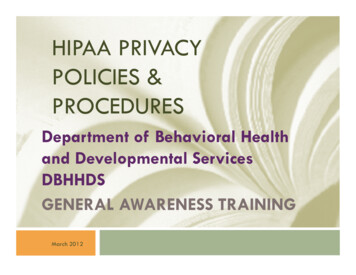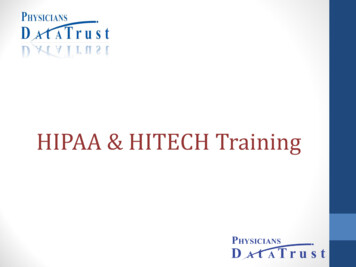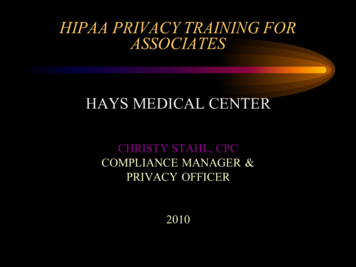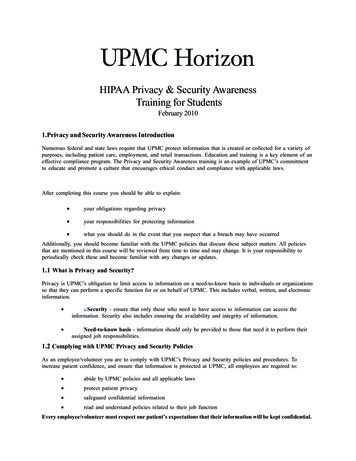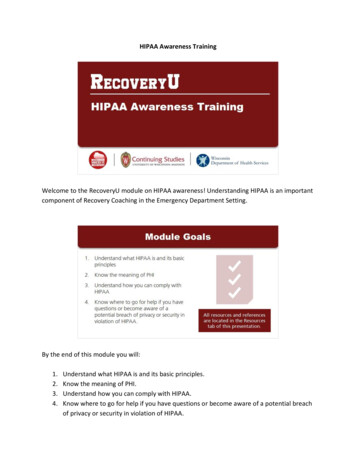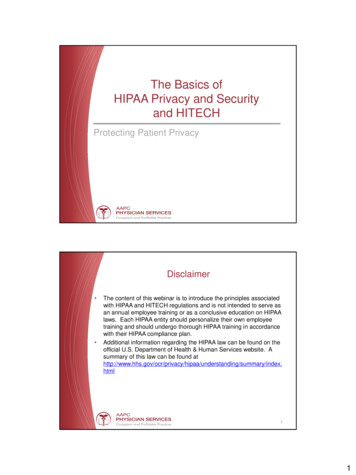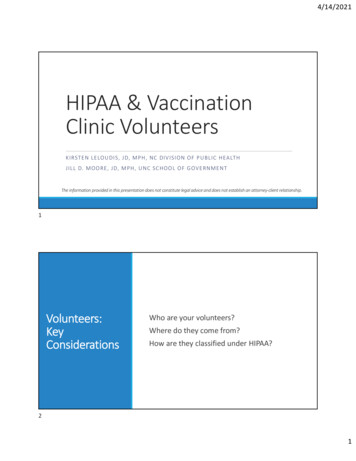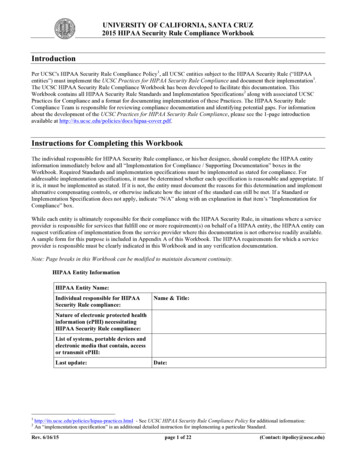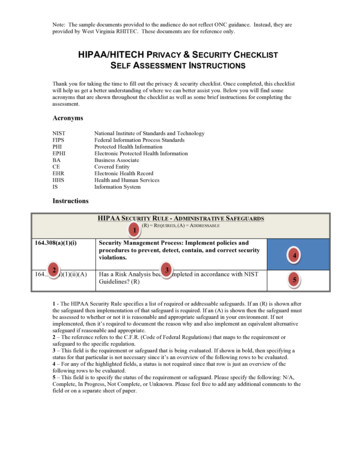
Transcription
VISTAS OnlineVISTAS Online is an innovative publication produced for the AmericanCounseling Association by Dr. Garry R. Walz and Dr. Jeanne C. Bleuerof Counseling Outfitters, LLC. Its purpose is to provide a means ofcapturing the ideas, information and experiences generated by theannual ACA Conference and selected ACA Division Conferences. Paperson a program or practice that has been validated through research orexperience may also be submitted. This digital collection of peer-reviewedarticles is authored by counselors, for counselors. VISTAS Online containsthe full text of over 500 proprietary counseling articles published from2004 to present.VISTAS articles and ACA Digests are located in the ACAOnline Library. To access the ACA Online Library, go tohttp://www.counseling.org/ and scroll down to the LIBRARYtab on the left of the homepage.nUnder the Start Your Search Now box, you may searchby author, title and key words.nThe ACA Online Library is a member’s only benefit.You can join today via the web: counseling.org and viathe phone: 800-347-6647 x222.Vistas is commissioned by and is property of the American CounselingAssociation, 5999 Stevenson Avenue, Alexandria,VA 22304. No part of Vistas may be reproduced without expresspermission of the American Counseling Association.All rights reserved.Join ACA at: http://www.counseling.org/
Suggested APA style reference:Freeburg, M. N., & McCaughan, A. M. (2008). HIPAA for dummies: A practitionersguide. In G. R. Walz, J. C. Bleuer, & R. K. Yep (Eds.), Compelling counselinginterventions: Celebrating VISTAS' fifth anniversary (pp. 305-312). Ann Arbor, MI:Counseling Outfitters.Article 29HIPAA for Dummies: A Practitioner’s GuideMelissa Niccole Freeburg and Ann Maureen McCaughanIntroductionSix months ago, we walked into the conference room of thenonprofit mental health clinic that we work at only to be met by thestressed-out faces of four counseling peers. The news was that ourclinic was to have a HIPAA review. We thought amongst ourselves,“HIPPA, they do reviews? And who exactly runs HIPAA?” We haveheard of the privacy act, and as patients know the utter annoyancefelt when signing the paperwork doctor visit after doctor visit. Asproviders, we know that compliance is necessary to safeguard ourclients. Some of us even have a few basic concepts picked up atrandom from sources we can no longer remember to give credit to.We bet you do too.At a psychiatric hospital one of us worked at on April 14,2003, the date of compliance for HIPAA, the facility had aCompliance Officer who gave a brief seminar on the topic. But let’sface it, back then I thought it was that guy’s problem, not mine. Nowthat the ball was in my court it was time to buff up on the needs ofour private practice.During our review of how our current facility works it wasshocking for us to realize the lack of general knowledge of our peers,and, of course, like many other things in our profession, the “gray”305
Compelling Counseling Interventionsarea of it all. In the true spirit of the now famous ‘How To’ books,these authors have broken up a ‘Must do’ for practicing counselingprofessionals in manageable bites. So, for those entering into yourfirst private practice, wait to hang up your shingle until you read therest of this article, for your and your client’s safety (although youmay want to order those business cards so they’ll be ready aroundthe same time as you are).HIPAA BasicsFirst, let’s get familiar with the acronyms. HIPAA stands forthe Health Insurance Portability and Accountability Act (1996).HIPPA was enacted by the U.S. Congress in 1996. Those thoughtfulpeople gave health professionals until April 14, 2003 to comply fullywith all properties of the act. For those of you counting, that was sevenyears to get things in order. Lucky for you, with the help of this article,it will not take that long. The intent of this Act is to protect clients,reduce fraud, improve quality of health care, and set strict standardsfor how private information about clients is transmitted (thewidespread use of electronic data transmissions made things fasterbut is considered risky; HIPAA, 1996). Think about the AmericanCounseling Association (ACA) ethics code. Like the ethics code,HIPAA was presented to ensure that health providers have commonstandards of practice, legitimacy, and to protect our clients.Ready for the next acronym? This is an important one, PHI,which stands for Protected Health Information. This concept is thebackbone, the purpose, of HIPAA in that information must beprotected for privacy and security. Finally, TPO stands for Treatment,Payment and Operations. This final acronym is really justinterchangeable with PHI. Just think, now you can impress yourfriends by interchanging acronyms on your whim!Next, get on-line and save http://www.hhs.gov/ocr/hipaa andhttp://www.hipaa.org on your browser’s favorites or the equivalentbased on the service you use. Then, get into your email account andsave these two addresses, AskHIPAA@cms.hhs.gov (transaction/codeset issues) and ocrprivacy@hhs.gov (privacy questions). Finally, go306
HIPAA for Dummies: A Practitioners Guideto the phone and save the Office for Civil Rights (OCR) hotlinenumber (1-800-537-7697). Now, at the ease of your fingertips youcan have your questions answered. Face it, there is no way we cancover it all for you here.The biggest asset you just gained for yourself is that of ourgovernment’s Office for Civil Rights (OCR) web page. Spend sometime making your way through all of the links. The web page offersa wealth of information under seven main categories: What’s Newin Privacy, For Consumers, General Background Information,HIPAA Regulations & Standards, Educational Materials, HIPAARelated Links, and Compliance & Enforcement. While you are theremake sure to sign up for the Privacy Listserv (occasional emails willbe sent to your account to help you stay current) and get your printerwarmed up. Our suggestion is to print off the complete Act and theFact Sheets, just to get started. Then move on over to the EducationMaterials and start from the top, we particularly like the sampleBusiness Associate contract. Make sure to take advantage of theforms available in Spanish too!Something important to know is that in some cases a clinicmay not be required to adhere to the rules and regulations of HIPAA.The Office for Civil Rights will definitely help you decipher whetheror not you need to maintain compliance. Not having to would be arelief wouldn’t it? Don’t get too excited, whether or not you have tomaintain compliance, our suggestion is to go ahead and do so. First,you may eventually evolve into a practice in which you will have tobe in compliance, and hey, look you already are! Second, it simplygives you professionalism, it will legitimize your work, and increaseconfidentiality for your clients, and are they not who you work for?Title INow, let us shift our focus to the materials included inHIPAA. In a snapshot, this regulation is broken up into two Titles.Title I: Health Care Access, Portability, and Renewability is designedto protect health insurance coverage for workers and their familieswhen they change or lose their jobs. This title stops group health307
Compelling Counseling Interventionsplans from creating eligibility rules or assessing premiums forindividuals in the plan based on health status, medical history, geneticinformation, or disability (HIPAA, 1996). Also, limits on restrictionsthat a group health plan can place on benefits for preexisting conditionsare provided. Title I also forbids individual health plans from denyingcoverage or imposing preexisting condition exclusions on individualswho have at least 18 months of creditable group coverage withoutsignificant breaks (any 63 day period) and who are not eligible to becovered under any group, state, or federal health plans at the time theyseek individual insurance (HIPAA, 1996).Title IITitle II: Preventing Health Care Fraud and Abuse;Administrative Simplification; Medical Liability Reform, is brokeninto five rules. These rules include: The Privacy Rule; TheTransactions and Code Sets Rule; The Security Rule; The UniqueIdentifiers Rule; and The Enforcement Rule. This title is focused ondefining offenses relating to health care and sets civil and criminalpenalties for them. The rules apply to health plans, health careclearinghouses, billing services, community health informationsystems, and health care providers (you) that transmit health caredata (HIPAA, 1996).Privacy RuleTwo of the Title II rules are of the most interest to us asproviders: The Privacy Rule and The Security Rule. The Privacy Ruleestablishes regulations for the use and disclosure of PHI (HIPAA,1996). In case you have already forgotten, PHI is Protected HealthInformation. Generally, PHI is any information about health status,provision of health care, payment, and medical records (HIPAA,1996). Basically, anything that identifies an individual. Now you cansee why TPO (Treatment, Payment and Operations) is aninterchangeable acronym with PHI. Now you have a general idea ofwhat PHI is, ready for the specifics? The list reads as follows: name308
HIPAA for Dummies: A Practitioners Guideaddress, name of relatives, name of employers, date of birth,telephone number, fax number, e-mail address, social securitynumber, medical record/account number, health plan number,certificate/license number, any vehicle or serial number, URL, fingeror voice prints, photographic images, and any other uniqueidentifying code or characteristic (HIPAA, 1996). Which even meansusing the word “blonde” in an elevator could be a violation (as iftalking about a client in an elevator isn’t bad enough).A common concern for providers is the terms in whichinformation can, should, or must be disclosed. If your client requeststheir information you have 30 days to provide it. Also, by law aprovider can be required to disclose information. For example, ifchild abuse is a concern with a client then your state child welfareagency requires some identifiable information. Give it to them, butlimit what you provide to the minimal amount that still allows you toachieve your intended purpose.So now that you know that information can leave your officeit is time to hear the catch. The Privacy Rule requires that you keepa record of your disclosures (HIPAA, 1996). For a counselor thismeans that you should chart your interactions with others, file yourRelease of Information forms, and make sure you have privacypolicies and procedures created and available upon request. Ready toadd a new title to your resume? Your private practice needs to appointa Privacy Official and contact person responsible for receivingcomplaints, and train all members of your office how to handle PHI.Security RuleThe Security Rule is broken into three specific types ofsecurity safeguards: administrative, physical, and technical. For eachof the three types the Rule identifies security standards and bothrequired and addressable implementation specifications. Requiredspecifications are a must and are expected to be followed down to theletter. The term addressable means there is some flexibility so that aclinic can evaluate how to best address the specifications withconsideration to their unique situation (HIPAA, 1996). Administrative309
Compelling Counseling InterventionsSafeguards are the policies and procedures designed to clearly showhow your practice will comply with HIPAA (1996). Make a list andstart checking things off. First, write a set of privacy procedures andmake sure to cite: the Privacy Official, reference management (whowill also be in compliance with security and any one that will haveaccess to PHI), authorization, establishment, modification, andtermination. Second, make a plan that outlines ongoing trainingregarding the handling of PHI. Third, if you use any outside businessas a support to your practice, such as a transcription company, makesure to ensure that they also have a framework in place to complywith HIPAA requirements. Fourth, create a contingency plan forresponding to emergencies, include data priority and failure analysis,testing activities, and change control procedures. Fifth, make a planfor internal audits to monitor security violations. In this plan,document the scope, frequency, and procedure of audits. Audits needto be routine and event-based, meaning if something seams fishy, doan audit. The final component of your procedure creations is that ofa document that addresses how security breaches that are discoveredwill be addressed. Remember, you do not have to reinvent the wheel.Examples of these procedures are available through the web site youso smartly saved.Physical Safeguards are those expectations to physicallymonitor any inappropriate access to protected data. This part of theRule states that hardware and software must be introduced to yourclinic safely and be removed properly (HIPAA, 1996). For example,if you hire a technician to come into your clinic to add newtechnology, make sure they can not access clients’ information. Ifyou decide to get a new computer, make sure the old one iscompletely cleared out before you donate it. Keep your records in aplace that no one can get to unless they are authorized. Employ thedouble lock rule, which means that someone must get through twolocks before getting to any PHI (e.g., locked door to file room andlocked filing cabinet). Now, PHI is not the only information you needto keep in secure areas, do not forget the facility security plans,maintenance records, visitor sign-in, and even parking permit lists,just to name a few (HIPAA, 1996).310
HIPAA for Dummies: A Practitioners GuideThe design of your office must also be a physical safeguardin itself. Have the workstations removed from high traffic areas andmake sure your computer screens face away from anyone other thanthe person sitting at the desk. Computer screen attachments areavailable that add additional safety in that the user must be directlyin front of the screen to view material. Critically examine the workplaces and remember that ancillary workers such as cleaning staffand paper shredding companies may make their way through theareas and you are responsible for their training or ensuring theirknowledge of physical access responsibilities (HIPAA, 1996).Technical Safeguards speak to your responsibility to governyour computer systems and people you deal with throughtechnological means (fax, email, phone, etc.). Think to yourself,“How will I ensure the person I intend to receive this materialREALLY receives it?” To do this, you should employ encryptionsystems and make sure that the people you deal with do the same(HIPAA, 1996). Remember, you need to have your plan for virtuallyeverything written out and you should make them available to thegovernment to prove that your counseling practice is in compliance.ComplianceCompliance is taken seriously by the United StatesGovernment. Just say the word “audit” and watch people sweat. Aswith any offense there comes fines and time behind bars. Complianceviolations start with 100 fines and can go all the way up to 250,000and 10 years in prison (HIPPA, 1996). Value your clients and do notever consider compromising their privacy whether inadvertently orwith intent for personal gain.Now, after hearing those scary fines we imagine you areready to throw in the towel and just hire some outside consultant tocome in and do it for you. You need to be aware that there have beenreports of fraudulent consulting companies claiming to have theendorsement of the Office of Civil Rights. If you decide the task it toochallenging, first, review the web sites again and seek supportthrough the email addresses and hotline number your saved earlier.311
Compelling Counseling InterventionsInterventionsSecond, go to your favorite book retailer and ask them to help youfind a resource guide, there are a number of quality books inpublication focused completely on HIPAA regulations. If you stillfeel the need to hire a consultant, demand them to show you proof oftheir accreditation by the United States Government, Office of CivilRights, and then follow that up by checking with the Office itself toconfirm the legitimacy of the accreditation.ConclusionIf you take nothing else from this article, please remember touse the Office of Civil Rights by emailing or phoning them to seekconsultation. Keep in mind that there are simple ways to ensure thesafety of our clients and their sensitive materials. For example, knockon doors before entering, use professional shredding companies toensure proper disposal, do not talk about clients in public areas, clearPHI from your computer screen before walking away, do not leavemessages on answering machines regarding clients, and do not mixPHI files with other files.ReferencesHealth Insurance Portability and Accountability Act (HIPAA) of1996, P.L. 104-191, 119 Stat.United States Health and Human Services. (2007). Office of civilrights – HIPAA. Retrieved October 26, 2007, fromhttp://www.hhs.gov/ocr/hipaa312
HIPAAforDummies:APractitionersGuide 309. h, rity
